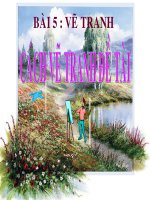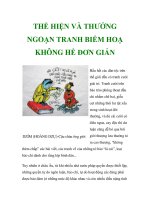Cách vẽ tranh biếm họa full
Bạn đang xem bản rút gọn của tài liệu. Xem và tải ngay bản đầy đủ của tài liệu tại đây (4.06 MB, 104 trang )
100648
8
CARICATURING
CARICATURING
A
Series of Lessons Covering All
Branches of the Art of Caricaturing
FULLY
ILLUSTRATED
CHICAGO
FREDERICK
J.
DRAKE & CO
Publishers
C3H1ICA.C5O
TMJE UTSHLTEO ST^^TTES
Foreword
In the writing and illustrating of this book my aim has been to
produce a comprehensive and concise treatise on the art of caricaturing.
It has been made as brief as is consistent with clearness and complete'
ness.
Although the text
many
is brief,
no
illustrations Ttfere spared.
plates illustrate all points necessary,
illustrated are explained in
illustration. In addition to
The
and each of the points
the text with reference to that particular
the plates there are many caricatures of
famous men included.
Acting upon the assumption that it is easier to work if ones
assignments are already made, Chapter XII has been made up of
assignments and suggestions, which makes this book a complete course
in caricaturing.
If you obtain half as
this
book
as I derived
shall consider
much
pleasure and profit
from writing, and
from the use of
especially illustrating
my time well spent.
Wishing you much
success.
Mitchell Smith.
6021294
it,
I
Contents
PAGE
Facing Tide
Frontispiece
7
Foreword
List of Illustrations
11
Chapter
I
Pen Lines and Material
15
Chapter
II
The Face and Head
2J
Chapter
III
Expression
31
Chapter
IV
Exaggeration
37
Chapter
V
Comic Figures
43
Chapter
VI
Action
47
Chapter VII"
Shading and Shadows
55
Chapter VIII
Technique
61
Chapter IX
Animals
69
Lettering
75
Chapter XI
This and That
81
Chapter XII
Assignments and Suggestions
85
Chapter
X
List of Illustrations
PAGE
George Arliss
Frontispiece
"
14
Plate 1
Nicola,
The Magician
16
17
Gladstone
Frederick,
The Great
18
'.".
Robert Herrick
19
Plate 2
22
Plate 3
24
Bolivar
26
Qemenceau
27
4
30
Plate 5
32
Marshal Foch
33
6
36
Plate 7
38
Bismarck
39
Plate 8
40
Plate 9
42
Plate
Plate
Robert Tristram
Coffin,
44
Poet
Plate 10
46
Plate 11
48
Benjamin Disraeli
49
11
List of Illustrations
12
PAGE
Hate 12
50
Lorado Taft
51
Marshal Joffre
52
Plate 13
54
Plate 14
'56
.Woodrow Wilson
57
Plate 15
60
Charles G.
Dawes
62
Jack Dempsey
63
Plate 16
64
Plate 17
68
Plate 18 .
. :
70
Josef Lhevinne
71
Charles Darwin
72
Plate 19
74
Caret Garrett
76
Joe Byrns
80
Booth Tarkington
84
Giovanni Martmelli
87
Caricaturing
14,
MMWWWTHGK."*"""'"
-
AV*E LIGHT TONCS,.
WITH FIN LINES/'
OR WloeLV SPACED
LINES. CflNDD'
CALLED
OR IKRCGUIAR LiMCS
HERRINGBONE WEAVE
=L
L
FOR DARK
AREAS
'/*oeo
"
i
^'
,^^-"*
STAMPED WITH
P5
PLATE
1
x
V
CLOW
CARICATURING
Chapter I
Pen Lines and Materials
The
necessary material used in drawing caricatures are few and
inexpensive if we compare them to the tools of some of the professions,
such as surgery,
etc.
The student of
caricaturing should procure a number of drawing
pens in various sizes. Gillotts drawing pens are perhaps the most
widely used of
pens by cartoonists and pen apdtjnk artists in
generaL For drawing cartoons and caricatures siw^70J^opand^^
are the ones moat uattk-Qtber si?es and styles oipBSsmay be very
useful; especiaU^^owl poin^ens for drawing heavy lines for the outlines of cartoons. mttrtTBook are reproduced a number of caricatures
all
that were outlined with a lettering pen
which enabled the artist to
get an- effect markedly original These lettering pens may be had
many sizes, and shaped with round, square or oblong nibs. The
student, or, prospective student is advised to obtain some of these,
because every artist should learn to manipulate the lettering pen and
brush in lettering. Nearly -all art work requires more or less hand
m
lettering.
Other materials needed are, black waterproof drawing ink
Higgins is very good and pencils for sketching arid drawing. All
drawings should be completely drawn with pencil before drawing in
ink. Art gum erasers, thumb tacks for fastening the drawing paper
or board to the drawing board will also be needed. The most satisfactory material to make the drawings on is a good grade of Bristoli
Board. But if the drawings are not intended for publication, a good
quality of heavy, hard surface bond paper gives satisfactory results,
and is also very good for sketching. Caricaturing requires a great deal
of sketching, and one should keep a supply of good paper for this
15
Caricaturing
16
record ideas and impressions before they escape from the
purpose, to
mental and
mind never to return from that oblivion where all things
material eventually go.
NICOLA
After which sudden outburst of scholarship and philosophy, let
us consider the manipulation of the pen, for the benefit of beginners
who are not familiar
this medium of drawing.
the same as in the proper position for
held
The drawing pen
of the
writing; that is, with the thumb and first and second fingers
with
is
right hand.
A variety
Fine
lines,
of pen lines are used in cartooning and caricaturing.
heavy
lines,
slow
lines, fast lines, irregular lines^
and shaky
GLADSTONE
most frequently used. On Plate 1 are illustrations of various
kinds of lines, dots, shading and etc. E, F and G are called Crosshatch
of
lines and they are used for shading. There are some examples
lines are
Crosshatch in the iUustrations
m this book;
Plate 1.
especially, of F,
Caricaturing
18
Q, R, S, T and U
decreasing the pressure on the pen; they
Graded
lines as in
are
drawn by
drawn
are best
increasing or
rapidly.
Ends
of lines dhat do not have their termination in other lines are usually
An example of this is Fig. 3, Plate 9.
drawn
thusly.
FREDERICK THE GREAT
K on
was made with a small camels hair brush, which
should have. L is also drawn with the same brush.
Plate 1
every cartoonist
Lines such as these are sometimes used to stripe trousers. See Fig. 4,
Plate 10.
is dots drawn with the brush, and
is termed
Spatter,
M
N
which
will
be explained
later.
Pen Lines and Materials
V
and
W
19
are stamped with pads of denim
and knit goods,
respectively. One can often create something original by experimenting*
and trying many ways and techniques of drawing an object* or
was used in drawing
caricature. The same pad used in stamping
W
the caricature of Robert Herrick.
HERRICK
In the drawing of caricatures and cartoons or any other com'
mercial art, for that matter the artist should know something about
the processes of reproduction for that particular form of art work.
For pen and ink work the engraving is made on a sine printing plate.
It is not necessary, however, to know all about these processes of
reproduction.
The
artist
should
know
that
all
work intended
for line
2o
Caricaturing
rqproducttons should be made on white paper or Bristol Board with
black drawing ink. The drawing to be reproduced is photographed on
a chemically treated sine plate, which is then treated with acid. This
away the surface of the sine, except the photographed' lines,
which are left in relief, somewhat like printing type. Colored inks do
acid eats
not photograph well; neither does black ink on colored paper.
Drawings are usually reduced about one-half the original
dimensions in reproduction, which makes them really one'fourth the
original sise. Since the dimensions are, of course, reduced in proportion,
it
naturally follows that the
pen
lines are also
reduced in the same
proportion in breadth, or thickness. Therefore, in
drawing for reproduction one should use heavier lines than
appear in a printed drawing.
Study the many drawings in this book to see how they have been
drawn. Notice that the outlines are invariably the heaviest, while the
lines for shading and such, are finer. Notice also how the lines have
been drawn, and how the pressure on the
has been decreased
pen
gradually at the end of lines to taper them, and avoid that cut off
appearance that results from bringing the pen to an abrupt stop at the
same pressure, making the entire line the same thickness.
Study an accomplished artist's work and take advantage of what
he knows, and put your own
original ideas in the drawing. This is the
road that leads to success in
art.









